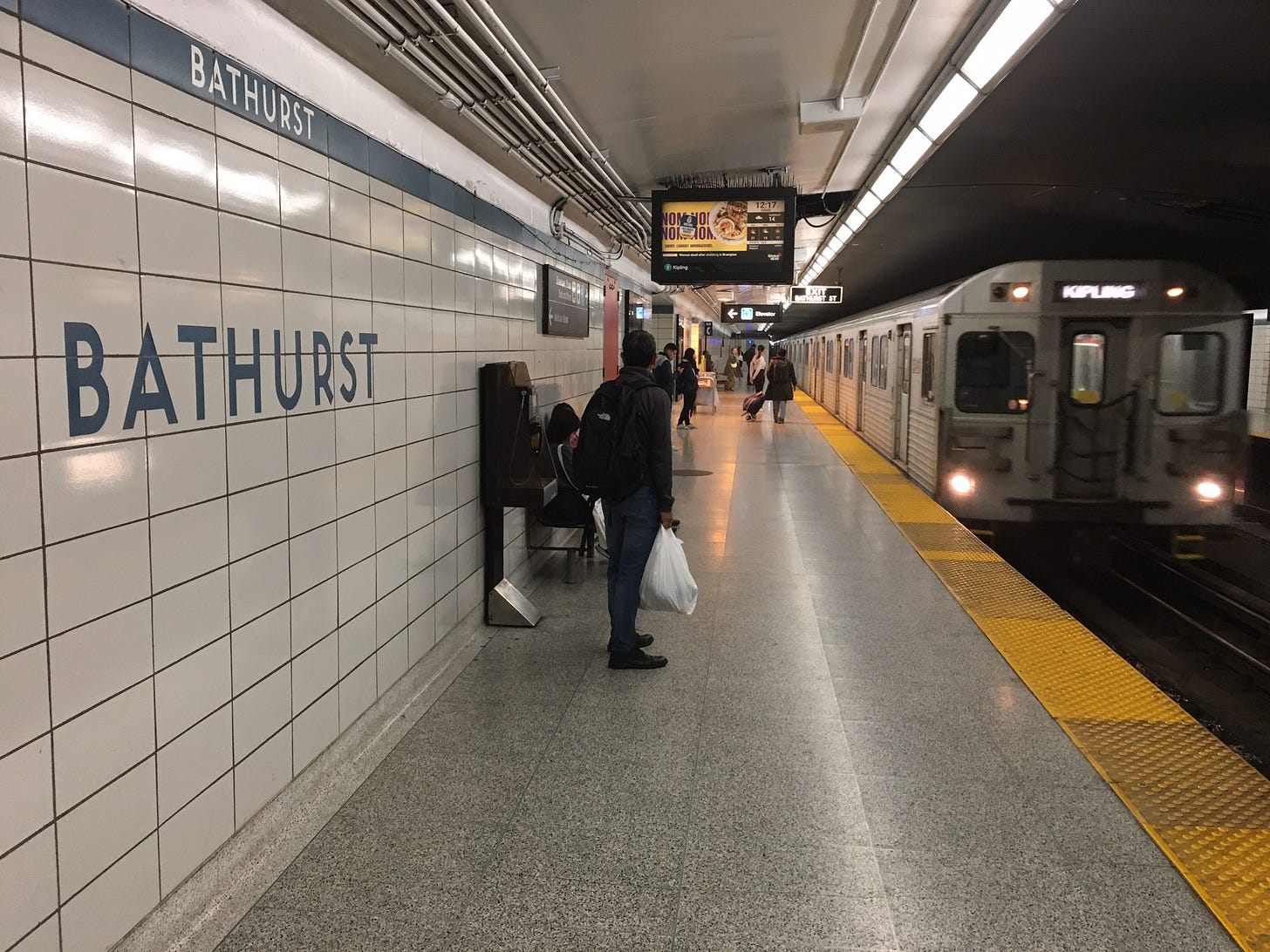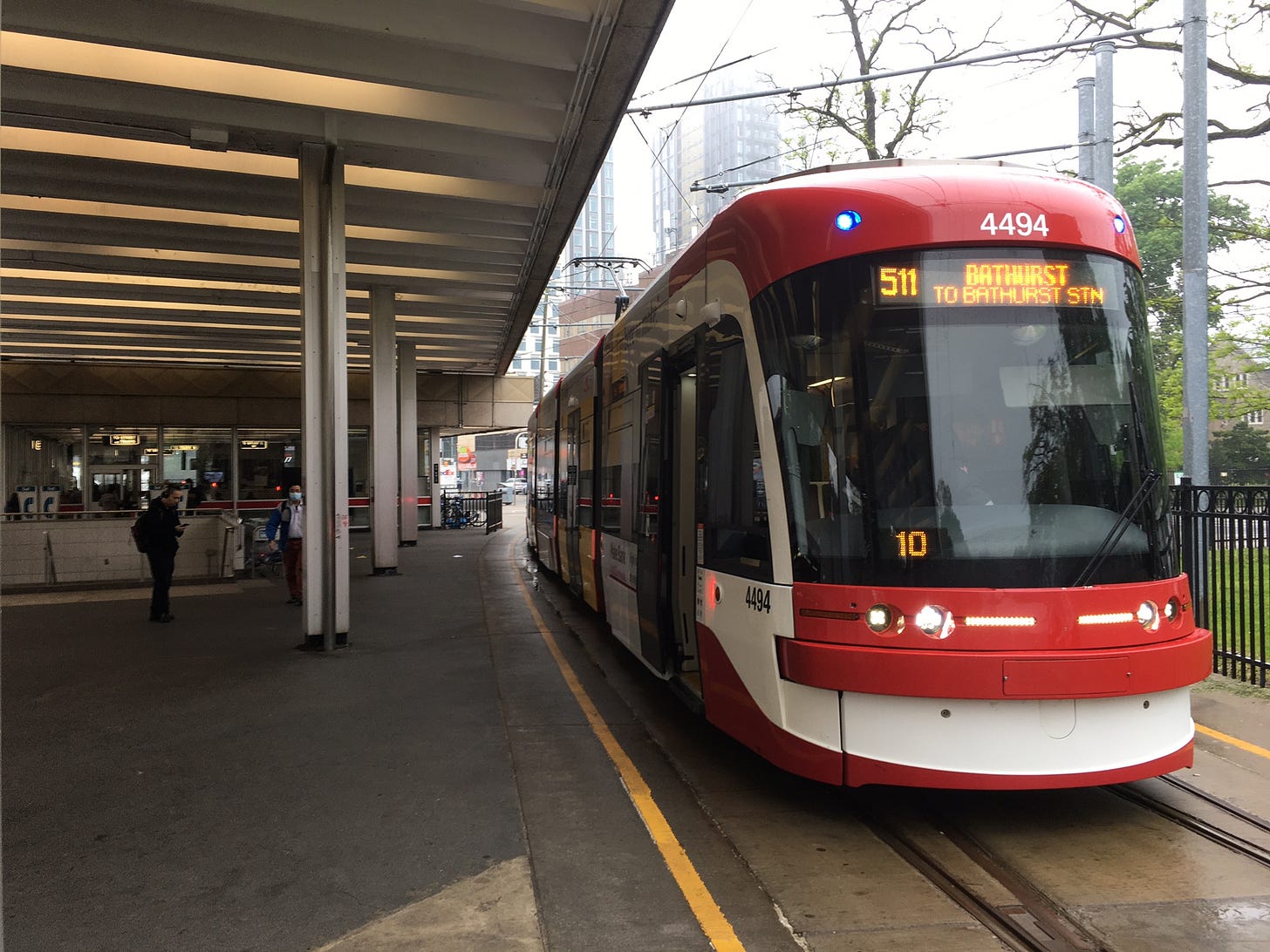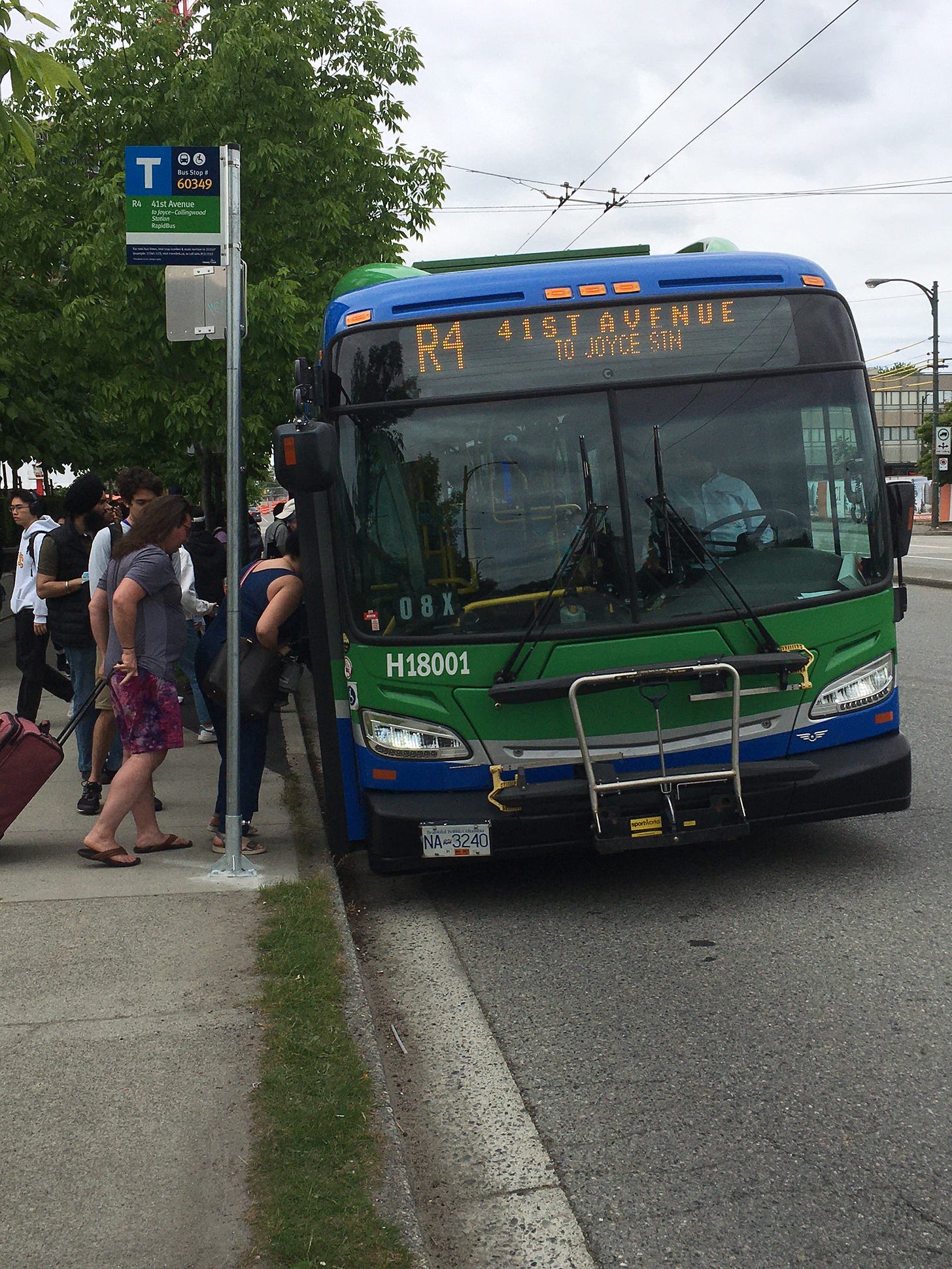In the last week, I’ve spent time in Canada’s three largest cities. With one exception—more on that later—I got around entirely by transit and bikeshare. The trip offered me a quick, panoramic view of the state of the state of public transport in Vancouver, Toronto, and Montreal.
Which city is the easiest to get around in without a private car in 2023? The answer may surprise you. It surprised me.
In the last decade, I’ve ridden transit in every major city in Canada, with the exception, I suppose, of Regina. Compared to Americans, we Canadians are heavy transit users. As transit consultant, author, and Human Transit blogger Jarrett Walker of Portland has pointed out, Canadians have earned the right to transit triumphalism: apart from the biggest, oldest metropolises in the U.S. (New York, Chicago, Boston), Canada has far higher mode-share for buses and trains than almost anywhere in the United States. Ottawa, which pioneered Bus Rapid Transit with its Transitways in 1983, now has the Confederation Line—basically a tram that runs on dedicated rights-of-way, and in underground stations in the downtown.1 Since 2019, Kitchener-Waterloo, an Ontario conurbation with a population of half a million, has been running the ION light rail system, with 29 stations. Even car-dependent Alberta has impressive light rail systems in its major cities; Calgary’s C Train, which runs on wind power, is in the midst of a major expansion of its Green Line. Most smaller cities rely on bus networks, but ridership tends to be high compared to American cities of comparable size.
Of course, everything is relative: compared to Europe and Asia, Canada is a laggard when it comes to breaking free of the private automobile. In such cities as Paris and Tokyo, or Copenhagen and Shanghai, it is entirely possible to live your entire life without a car and not feel like you’re inconvenienced, deprived, or missing out on anything. Canada’s cities may be closer to this enviable position than most US cities are—but they’re not there yet.
Last week, I began a cross-country journey by rolling my suitcase down to the corner from my home, where a Montreal city bus, running on ten-minute frequencies, whisked me over a viaduct to the Rosemont metro station. From there, the Orange Line took me to the Bonaventure Station in under 20 minutes. I boarded an intercity Via Rail train which got me to Toronto in 6 hours. (It was meant to be 5 hours—hell, with high-speed rail the trip could take just 2.5 hours; you can read my stroppy observations on passenger rail in Canada in last week’s dispatch.) Arriving in Toronto’s Union Station, I took the new underground concourse to the TTC subway station, tapped my PRESTO farecard, which I’d preloaded on the train, and rode the Yonge Line north to a station near my hotel.
So far, so good. When I wrote about Canada’s largest city in my book Straphanger, I titled the chapter “The Toronto Tragedy.” The then mayor, the late Rob Ford, was famous for hating light-rail, for removing bike lanes, and for his counter-offensive on a perceived “War on Cars.” Since then, the u-shaped Yonge-University Line has been extended north to the suburb of Vaughan to the west, and to Finch in the east. And a truly impressive transit expansion is underway. It includes the building of the Ontario Line (basically the Downtown Relief Line, a project that should have been started fifty years ago), the completion of the Eglinton crosstown light-rail line, and the electrification of the GO Trains, the Ontario government’s system of commuter rail trains.
All of that, however, is “to come.” In the spring of 2023, getting around Toronto without a car remains frustrating. I had interviews set up throughout the downtown and east of the city, and I was often stymied by the structural illogic of the transit network. The horseshoe-shaped Yonge-University line, which loops from north to south at Union Station, near Lake Ontario, is the north-south spine of the subway. But downtown, the lines run parallel within two or three blocks of each other. The other major subway line, the east-west Bloor line, is located 3.5 km north of Union Station. (And somehow, you can’t get cell phone reception for most of the underground sections of the line. Really, TTC? Your riders don’t deserve boosters in the tunnels?) That means that much of downtown Toronto is served by buses and streetcars.
Don’t get me wrong. I do love streetcars, and it’s amazing that Toronto, like New Orleans, held on to its historic system. The problem is, when the streetcars run east-west through the downtown, they can be agonizingly slow. (When they run north-south on broad streets like Bathurst and Spadina, in some stretches on near dedicated rights-of-way, their progress tends to be faster; and the way they mesh with the subway station entrances is a model of good planning.) And because they share the streets with cars, any impediment—an emergency vehicle, a double-parked car, a driver-passenger conflict—can bring them, and all the streetcars behind them, to a complete stand-still. Half the time I decided to get out of the streetcar I was on and walk. Or, better yet, grab a bicycle from a Toronto Bikeshare stand. Riding a bike in Toronto can still be hairy—unlike Montreal, where drivers are merely reliably impatient, here many seem positively hostile to cyclists. But the protected bike path network has really improved, and some lanes, like the one along Bloor, are downright enjoyable to use.
I tried to ride the train to Pearson Airport for an early flight, but when I arrived at Union Station, where I planned to take the UP Express, the “train-to-the-plane,” the doors were locked. It turns out I’d been looking at a weekday schedule for the train. So I was forced into a taxi, which set me back $70, including the tip. Big sigh.
Arriving in Vancouver, though, I was back in transit land. A Canada Line train was waiting for me a short walk along a covered walkway outside the terminal. Frequent departures, headways of as little as five minutes. I rode the train to the Aberdeen Station in Richmond, and rolled my bag to the Lido, a fluo-lit Hong Kong-style café, where I had one of my favorite all-time breakfasts (rice roll, yin-yang coffee, pineapple bun). Then, after killing some time in the Asian malls on No. 3 Road, I re-boarded the Canada Line, which dropped me off, after a soaring ride over the Fraser River, at an underground station near my downtown hotel.
I’ve long maintained that Vancouver should be seen as a model of successful transit implementation for North America. I grew up here, and I remember when the Skytrain, which runs driverless electric trains in tunnels and on elevated tracks, first appeared for Expo 86. It felt like a typical World’s Fair project—a glorified monorail. But it has proved to be remarkably robust, and the system has since been extended deep into the east of the city, to Coquitlam and beyond, and south of the Fraser River to Surrey. They’re in the process of building the Broadway Subway, an extension of the east-west Millennium Line, which will eventually reach my old alma mater, the University of British Columbia.
Vancouver also does express buses very well. This worked especially well on 41st Avenue, where I boarded a bus outside a Canada Line station and was whisked east to my destination so fast I didn’t even have time to finish answering an email. It didn’t work quite so well on the B99, because construction of the Broadway Subway has created choke points that are slowing everything down. For now. These buses could definitely benefit from signal priority, which would change red lights to green as buses approached.
I grew up riding Vancouver’s trolleys—they were streamlined Brill buses back in the day. Rubber-tired trolley buses still pligh the streets. And, they still suffer from the issues that drove me crazy with impatience when I was a teenager. Like Toronto’s streetcars, they are vulnerable to slowdowns and complete stops when there are issues with traffic or driver-passenger conflicts. (This was the case when a disgruntled passenger, heavily laden with plastic bags, kicked the front door when he thought the driver had closed the door on him too quickly. The driver decided to call dispatch, but without lowering his trolley poles, stranding everyone on the bus—and three buses behind him—for ten minutes or so.) It’s especially bad when the buses go down Granville Street, one of downtown’s main commercial strips. Things often slow to walking speed there, or slower. It can be as excruciating as being on the King Streetcar in Toronto in rush hour. True signal priority for transit vehicles—not just express buses—would go a long way to resolving this issue.
I continue to believe that Vancouver, and its region-wide transit authority, Translink (with its super-convenient Compass farecard), is a model for other cities. Once you’re on the Skytrain, Canada Line, the frequent-bus network, or the Seabus, which links downtown to North Vancouver, you feel like you’re in transit utopia: you’re getting where you want to go faster, and just about as comfortably, as if you were in a car. It’s when you’re on the local buses, which move in mixed traffic, and are prone to the same kind of slowdowns as Toronto streetcars, that you feel like you’ve become—for want of a better term—a second-class citizen.
That’s why I think that, for the time being, Montreal qualifies as Canada’s most functional transit metropolis. True, it also has its share of poky local buses, which get tangled in downtown traffic. (Transit critic Marco Chitti has come up with a scheme for rationalizing these illogical routes, which have been in existence for decades.) But the existing metro serves the downtown better than Toronto’s subway serves its downtown. Though standards have slipped a bit since the pandemic, the frequent bus network is still extensive. And the new Bus Rapid Transit line on Blvd. Pie-IX is exactly what BRT should be. (More about my experience riding it here.) There are great things coming down the pipe: the first leg of the ambitious Réseau Express Métropolitain, a Skytrain-like driverless elevated, is about to open, and the eastern extension of the métro’s Blue Line is being dug to meet up with the Pie-IX BRT in the east end. Montreal’s bikeshare system, Bixi, which was one of the first on this continent, is now matched to an impressive, and ever-growing, network of bicycle lanes; and the fleet of cars, most of them hybrids or electric, managed by the pioneering carshare service Communauto is impressively big, and expanding.
In the not-too-distant future, I’ll be able to ride an REM train from the airport to within one station of my home. This time around, I was on the 747 Bus, the express bus ($11 one-way), which goes directly from the airport to the métro system. But even though I was on a bus, rather than a sleek train, I was smiling: the 747 runs in a reserved lane, which meant that we were rushing past drivers stuck in traffic on the highway during the afternoon rush-hour. I finished my cross-country trip, after a short metro ride, with a stroll through my neighborhood and back home in time for dinner.
This is the situation in Canada, as one straphanger sees it, as of spring, 2023. Montreal is ahead of the game—for now. The good news is that, once their transit expansions are complete, my city is going to have serious competition from Toronto and Vancouver.
Now if they can just work on those streetcars and trolleys…
_______
I hope you’ll consider becoming a paid subscriber to my Straphanger Substack. Almost everybody who’s signed up so far is a “free rider.” No shame in that. But to keep this bus going, I’m going to need at least a few people who are willing to help out by chipping in, even with a low-priced monthly subscription. (I’m talking the price of two taps of your farecard here!)
Rushed to completion, the Confederation Line has been plagued by a series of operational problems: https://www.cbc.ca/news/canada/ottawa/lrt-inquiry-final-report-ottawa-problems-recommendations-1.6668152







